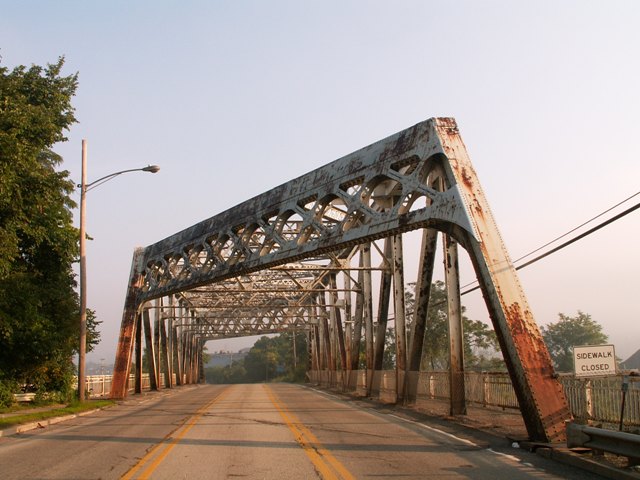We Recommend:
Bach Steel - Experts at historic truss bridge restoration.
BridgeHunter.com Phase 1 is released to the public! - Visit Now
Pennsylvania Avenue Bridge

Primary Photographer(s): Nathan Holth and Rick McOmber
Bridge Documented: August 2007 and July 14, 2011
Monaca: Beaver County, Pennsylvania: United States
1938 By Builder/Contractor: Fort Pitt Bridge Works of Pittsburgh, Pennsylvania and Engineer/Design: Pennsylvania State Highway Department
1971
180.0 Feet (54.9 Meters)
184.0 Feet (56.1 Meters)
34 Feet (10.36 Meters)
1 Main Span(s)
4005101600000

View Information About HSR Ratings
Bridge Documentation
This bridge no longer exists!
View Archived National Bridge Inventory Report - Has Additional Details and Evaluation
This historic bridge was demolished and replaced by PennDOT in 2011!

This bridge is an attractive example of a 1930s standard plan truss bridge in Pennsylvania. The bridge is quite skewed, which adds to the interest of the structure. The bridge has not been properly maintained, and the sidewalk has deteriorated severely. This bridge is yet another example of how improper attention to maintenance has resulted in the loss of fiscal efficiency, but more importantly, this results in the loss of historic structures that could otherwise continue to be beautiful and functional parts of this country's transportation infrastructure.
PennDOT was recently rewarded for its impressive wasting of taxpayer dollars by being allowed the funds to replace this bridge on new alignment, the conclusion of which includes the demolition of this bridge, and the loss of yet another so-called "not historic" 1930s riveted truss bridge with a heavy skew. Historicbridges.org has long argued that bridges like this should be considered historic. While they may have not introduced new design methods when they were built in the 1930s, they remain a record of the craftsmen who built them, and are further a record of the unique bridge designs developed by the state highway department... as well as the rivets and built-up beams... all features and designs not used since at least the 1960s, and features which are never to be used or seen again in anything but historic preservation work. They are for this reason very worthy of being called historic and deserving of preservation.
Information and Findings From Pennsylvania's Historic Bridge InventoryDiscussion of Bridge The skewed, one span, 190'-long, riveted Pratt thru truss bridge built in 1938 is supported on horizontally scored concrete abutments with wingwalls. The trusses are traditionally composed with rolled section used for the web members. The portal braces are bulky because of the extreme skew. The bridge is typical of the department's late 1930s high capacity truss designs, and it is not technologically significant. The bridge was built to enhance vehicular traffic, not the efficiency of the railroad, so it is not historically significant in association with the railroad. Discussion of Surrounding Area The bridge carries a three-lane road and sidewalks over six Pittsburgh & Lake Erie Railroad tracks in Monaca. There is a modern strip shopping center beyond the southwest quadrant, and the Pittsburgh Tube Co. mill beyond the north end. The railroad was a major regional hauler of steel-related raw materials and products. Bridge Considered Historic By Survey: No |
![]()
Photo Galleries and Videos: Pennsylvania Avenue Bridge
Bridge Photo-Documentation
Original / Full Size PhotosA collection of overview and detail photos. This gallery offers photos in the highest available resolution and file size in a touch-friendly popup viewer.
Alternatively, Browse Without Using Viewer
![]()
Bridge Photo-Documentation
Mobile Optimized PhotosA collection of overview and detail photos. This gallery features data-friendly, fast-loading photos in a touch-friendly popup viewer.
Alternatively, Browse Without Using Viewer
![]()
Maps and Links: Pennsylvania Avenue Bridge
This historic bridge has been demolished. This map is shown for reference purposes only.
Coordinates (Latitude, Longitude):
Search For Additional Bridge Listings:
Bridgehunter.com: View listed bridges within 0.5 miles (0.8 kilometers) of this bridge.
Bridgehunter.com: View listed bridges within 10 miles (16 kilometers) of this bridge.
Additional Maps:
Google Streetview (If Available)
GeoHack (Additional Links and Coordinates)
Apple Maps (Via DuckDuckGo Search)
Apple Maps (Apple devices only)
Android: Open Location In Your Map or GPS App
Flickr Gallery (Find Nearby Photos)
Wikimedia Commons (Find Nearby Photos)
Directions Via Sygic For Android
Directions Via Sygic For iOS and Android Dolphin Browser
USGS National Map (United States Only)
Historical USGS Topo Maps (United States Only)
Historic Aerials (United States Only)
CalTopo Maps (United States Only)

